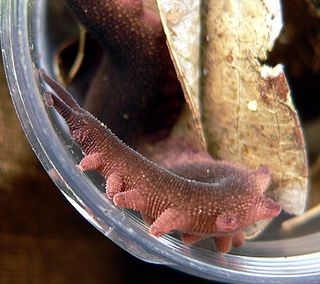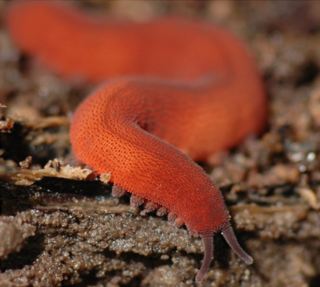
Peripatus is a genus of velvet worms in the Peripatidae family. The name "peripatus" is also used to refer to the Onychophora as a whole, although this group comprises many other genera besides Peripatus. The genus Peripatus is found in Central America, the Caribbean and northern South America. This genus is viviparous, with mothers supplying nourishment to their embryos through a placenta.

Eoperipatus is a genus of velvet worms in the family Peripatidae. These velvet worms have been reported from locations throughout Southeast Asia, including Malaysia, Singapore, Thailand, and Vietnam. This genus exhibits lecithotrophic ovoviviparity; that is, mothers in this genus retain yolky eggs in their uteri.

Epiperipatus is the most diverse genus of neotropical velvet worms in the family Peripatidae. Species in this genus are found in Central and South America. This genus is viviparous, with mothers supplying nourishment to their embryos through a placenta.

Eoperipatus totoro is a species of velvet worm of the family Peripatidae. This species is notable as the first velvet worm from Vietnam to be formally described. As of 2023, E. totoro remains the only species of velvet worm from Vietnam to be described.
Epiperipatus imthurni is a species of velvet worm in the family Peripatidae. This species ranges from light orange or yellowish brown to a dark brown on its dorsal surface; the ventral surface is a lighter orangeish shade of the same color. The type locality is in Guyana. No males have been recorded from this species. Females can reach a large size, up to 2.25 g in weight, and range from 25 mm up to 96 mm in length. They have 29 to 32 pairs of legs, usually 30 or 31. Females from Trinidad were shown to reproduce via parthenogenesis; the only velvet worm known to do so.
Epiperipatus adenocryptus is a species of velvet worm in the Peripatidae family. This species is brown with a series of light brown arcs on each side forming a series of circles down its dorsal surface. Males of this species have 26 or 27 pairs of legs, usually 27; females have 28 to 30, usually 29. The type locality is in Minas Gerais, Brazil.

Epiperipatus brasiliensis is a species of velvet worm in the Peripatidae family. Males of this species have 29 pairs of legs; females have 31 or 33. This species ranges from 37 mm to 80 mm in length. The type locality is in Pará, Brazil. Epiperipatus vagans from Barro Colorado Island (Panama) was originally described as subspecies of Epiperipatus brasiliensis, but is now treated as a full species.
Epiperipatus cratensis is a species of velvet worm in the family Peripatidae. This species is found in northeastern Brazil. This velvet worm is notable as a small species of Epiperipatus with many legs.
Epiperipatus diadenoproctus is a species of velvet worm in the Peripatidae family. This species is brown with a series of light brown arcs on each side forming circles down its back. Males of this species have 26 to 28 pairs of legs, usually 27; females have 29 or 30, usually 29. The type locality is in Minas Gerais, Brazil.
Epiperipatus vespucci is a species of velvet worm in the Peripatidae family. This species is dark with a complex pattern on its dorsal surface. The male of this species has 30 pairs of legs; females have 33 or 34. The type locality is in Colombia.
Epiperipatus paurognostus is a species of velvet worm in the Peripatidae family. This species is brown with a series of light brown arcs on each side forming circles down its back. Males of this species have 26 or 27 pairs of legs, usually 27; females have 27 to 29, usually 29. The type locality is in Minas Gerais, Brazil.

Epiperipatus edwardsii is a species of velvet worm in the family Peripatidae. Females of this species have 29 to 34 pairs of legs; males have 28 to 30. Females range from 23 mm to 56 mm in length, whereas males range from 25 mm to 30 mm. The type locality is in French Guiana.
Epiperipatus machadoi is a species of velvet worm in the Peripatidae family. This species is dark brown with a series of light brown arcs on each side forming circles down its back and ranges from 20 mm to 66 mm in length. Males of this species have 27 to 29 pairs of legs, usually 28; females have 28 to 31, usually 31. The type locality is in Minas Gerais, Brazil.
Epiperipatus ohausi is a species of velvet worm in the family Peripatidae. Males of this species have 26 to 28 pairs of legs; females have 27 to 29.

Peripatus juanensis is a species of velvet worm in the Peripatidae family discovered in Puerto Rico in 1900. As of 2018, it is the only velvet worm found in Puerto Rico. Females of this species have 31 or 32 pairs of legs; males have 27.
Mongeperipatus solorzanoi, also known as Solórzano's velvet worm, is a species of velvet worm in the family Peripatidae. This species is the largest known velvet worm, reaching 22 cm in length. This velvet worm is found in the Caribbean coastal forest of Costa Rica.
Epiperipatus beckeri is a species of velvet worm in the family Peripatidae. Females of this species have 28 to 30 pairs of legs. The type locality is in Bahia state in Brazil.
Epiperipatus lucerna is a species of velvet worm in the family Peripatidae. The males of this species have 27 to 29 pairs of legs; females have 29 to 31 pairs. The type locality is in Alagoas state in Brazil.
Epiperipatus titanicus is a species of velvet worm in the family Peripatidae. This velvet worm is known only from its type locality in the state of Alagoas in Brazil. The species name refers to the large size of its females and its numerous legs. This species features more legs than any other Brazilian species of velvet worm.
Oroperipatus tiputini is a species of velvet worm in the Peripatidae family.





